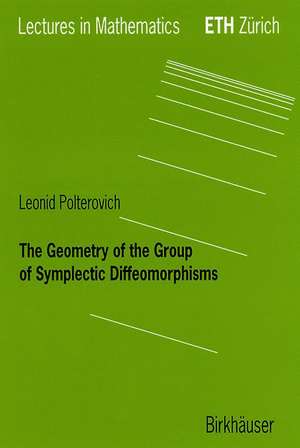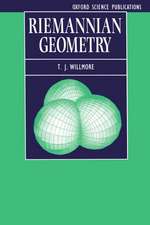The Geometry of the Group of Symplectic Diffeomorphism: Lectures in Mathematics. ETH Zürich
Autor Leonid Polterovichen Limba Engleză Paperback – mar 2001
Din seria Lectures in Mathematics. ETH Zürich
-
 Preț: 319.43 lei
Preț: 319.43 lei -
 Preț: 453.98 lei
Preț: 453.98 lei -
 Preț: 482.56 lei
Preț: 482.56 lei -
 Preț: 348.77 lei
Preț: 348.77 lei -
 Preț: 379.30 lei
Preț: 379.30 lei -
 Preț: 383.93 lei
Preț: 383.93 lei -
 Preț: 378.71 lei
Preț: 378.71 lei - 15%
 Preț: 492.73 lei
Preț: 492.73 lei -
 Preț: 385.84 lei
Preț: 385.84 lei -
 Preț: 381.98 lei
Preț: 381.98 lei -
 Preț: 381.21 lei
Preț: 381.21 lei -
 Preț: 345.12 lei
Preț: 345.12 lei -
 Preț: 381.43 lei
Preț: 381.43 lei - 18%
 Preț: 735.84 lei
Preț: 735.84 lei - 15%
 Preț: 491.75 lei
Preț: 491.75 lei -
 Preț: 414.80 lei
Preț: 414.80 lei -
 Preț: 395.25 lei
Preț: 395.25 lei -
 Preț: 345.45 lei
Preț: 345.45 lei -
 Preț: 447.03 lei
Preț: 447.03 lei -
 Preț: 380.45 lei
Preț: 380.45 lei -
 Preț: 350.24 lei
Preț: 350.24 lei -
 Preț: 347.15 lei
Preț: 347.15 lei -
 Preț: 382.36 lei
Preț: 382.36 lei -
 Preț: 383.71 lei
Preț: 383.71 lei -
 Preț: 447.62 lei
Preț: 447.62 lei -
 Preț: 381.98 lei
Preț: 381.98 lei - 18%
 Preț: 907.11 lei
Preț: 907.11 lei
Preț: 493.37 lei
Preț vechi: 580.44 lei
-15% Nou
Puncte Express: 740
Preț estimativ în valută:
94.42€ • 102.52$ • 79.31£
94.42€ • 102.52$ • 79.31£
Carte tipărită la comandă
Livrare economică 22 aprilie-06 mai
Preluare comenzi: 021 569.72.76
Specificații
ISBN-13: 9783764364328
ISBN-10: 3764364327
Pagini: 148
Ilustrații: XII, 136 p. 2 illus.
Dimensiuni: 170 x 240 x 8 mm
Greutate: 0.25 kg
Ediția:2001
Editura: Birkhäuser Basel
Colecția Birkhäuser
Seria Lectures in Mathematics. ETH Zürich
Locul publicării:Basel, Switzerland
ISBN-10: 3764364327
Pagini: 148
Ilustrații: XII, 136 p. 2 illus.
Dimensiuni: 170 x 240 x 8 mm
Greutate: 0.25 kg
Ediția:2001
Editura: Birkhäuser Basel
Colecția Birkhäuser
Seria Lectures in Mathematics. ETH Zürich
Locul publicării:Basel, Switzerland
Public țintă
ResearchCuprins
Preface.- 1 Introducing the Group.- 1.1 The origins of Hamiltonian diffeomorphisms.- 1.2 Flows and paths of diffeomorphisms.- 1.3 Classical mechanics.- 1.4 The group of Hamiltonian diffeomorphisms.- 1.5 Algebraic properties of Ham(M, Q).- 2 Introducing the Geometry.- 2.1 A variational problem.- 2.2 Biinvariant geometries on Ham(M, Q).- 2.3 The choice of the norm: Lp vs. Loa.- 2.4 The concept of displacement energy.- 3 Lagrangian Submanifolds.- 3.1 Definitions and examples.- 3.2 The Liouville class.- 3.3 Estimating the displacement energy.- 4 The $$\bar \partial$$-Equation.- 4.1 Introducing the $$\bar \partial$$-operator.- 4.2 The boundary value problem.- 4.3 An application to the Liouville class.- 4.4 An example.- 5 Linearization.- 5.1 The space of periodic Hamiltonians.- 5.2 Regularization.- 5.3 Paths in a given homotopy class.- 6 Lagrangian Intersections.- 6.1 Exact Lagrangian isotopies.- 6.2 Lagrangian intersections.- 6.3 An application to Hamiltonian loops.- 7 Diameter.- 7.1 The starting estimate.- 7.2 The fundamental group.- 7.3 The length spectrum.- 7.4 Refining the estimate.- 8 Growth and Dynamics.- 8.1 Invariant tori of classical mechanics.- 8.2 Growth of one-parameter subgroups.- 8.3 Curve shortening in Hofer’s geometry.- 8.4 What happens when the asymptotic growth vanishes?.- 9 Length Spectrum.- 9.1 The positive and negative parts of Hofer’s norm.- 9.2 Symplectic fibrations over S2.- 9.3 Symplectic connections.- 9.4 An application to length spectrum.- 10 Deformations of Symplectic Forms.- 10.1 The deformation problem.- 10.2 The $$\bar \partial$$-equation revisited.- 10.3 An application to coupling.- 10.4 Pseudo-holomorphic curves.- 10.5 Persistence of exceptional spheres.- 11 Ergodic Theory.- 11.1 Hamiltonian loops as dynamical objects.- 11.2 Theasymptotic length spectrum.- 11.3 Geometry via algebra.- 12 Geodesics.- 12.1 What are geodesics?.- 12.2 Description of geodesics.- 12.3 Stability and conjugate points.- 12.4 The second variation formula.- 12.5 Analysis of the second variation formula.- 12.6 Length minimizing geodesics.- 13 Floer Homology.- 13.1 Near the entrance.- 13.2 Morse homology in finite dimensions.- 13.3 Floer homology.- 13.4 An application to geodesics.- 13.5 Towards the exit.- 14 Non-Hamiltonian Diffeomorphisms.- 14.1 The flux homomorphism.- 14.2 The flux conjecture.- 14.3 Links to “hard” symplectic topology.- 14.4 Isometries in Hofer’s geometry.- List of Symbols.


















